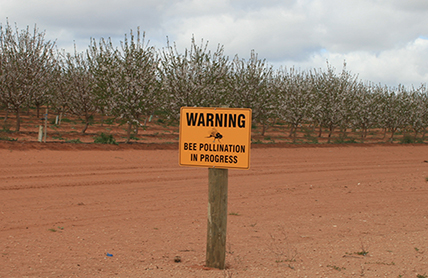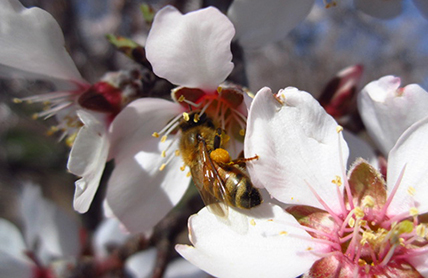
Pesticides – reducing damage to honey bees
148
Third
Jun 2020
Elizabeth Frost
Introduction
Pesticides are used in agriculture, horticulture, and in field and forest situations to control a wide range of insect pests and weeds. To learn more about specific pesticides that are registered, toxic to bees and are used in situations where bees may come into contact with them consult the BeeAware website.
Practices to minimise damage to honey bees from pesticides are essential within programs developed by persons applying pesticides and by beekeepers operating apiaries in areas where pesticides are applied.
Report bee poisoning in NSW
Report a honey bee pesticide event in New South Wales by contacting the Environment Protection Authority on 131 555 or visit www.epa.nsw.gov.au.
How bee poisoning occurs

- Bee poisoning generally occurs after a pesticide has been applied to crops or weeds which contain flowers or are providing secretions attractive to bees, e.g. from extra-floral nectaries, such as exist in cotton plants.
- The pesticide is applied directly onto bees foraging on the crop.
- Bees fly to the treated plants and collect contaminated nectar and/or pollen.
- Bees collect contaminated water on or near treated plants.
- Bees forage on a cover crop associated with the treated crop, e.g. brassica or clover in an orchard.
- Pollen collecting bees collect pesticide dust and/or contaminated pollen and return these to the hive.
- Pesticides drift from their point of application onto flowering plants or across hives in apiaries.
Field symptoms of pesticide poisoning
- Most commonly, large numbers of adult bees are found dead on the ground in front of the hives.
- Most or all of the hives in the apiary are affected.
- Adult bees all die within a few days of each other.
- Dead adult bees typically, but not always, have their wings unhooked and at odd angles to their body, their proboscis (i.e. “tongue”) fully extended, and their hind pair of legs outstretched behind them.
- In severe cases, dead adult bees will be present inside the hive between the frames and on the hive floor.
- Beekeepers observe a lack of foraging bees.
- Live adult bees may move slowly or behave abnormally, showing signs of paralysis.
- Surviving bees often show abnormal signs of aggressiveness.
- In severe cases, when insufficient numbers of adult bees remain, temperature and humidity control in the brood area is lost and brood is not fed. Brood die from chilling, overheating or starvation.
- Queen failure may occur within 30 days from the first date of poisoning.
- Some pesticides, particularly systemic pesticides, have a less noticeable, but debilitating effect, resulting in an overall weakening of the colony. Signs are reduction in adult bee numbers and stages of the brood cycle or complete brood cycles missing.
Management of poisoned hives
- Move hives to a safe area.
- Keep bees warm by removing excess supers.
- Feed colonies inside the hive with a 1:1 water:sugar syrup until recovered. Loss of field bees results in a lack of fresh nectar and water being brought into the hive.
- Add frames of sealed brood and adult bees from healthy hives, if required.
- Be prepared to manage the hives for queen failure or supersedure problems which may occur a number of weeks after the initial pesticide poisoning event.
Beekeeper practices to reduce bee poisoning

- Publicise the presence of your apiaries, communicating with persons and authorities likely to be applying pesticides:
- property owners within bee flight range of your apiaries.
- aerial operators applying pesticides in areas around your apiaries. More than one company may be involved and aerial operators often travel large distances from their home base to apply pesticides. Information on aerial operators in your area may be obtained from NSW DPI horticulture or agriculture industry development officers.
- Information required to be provided by the beekeeper to property owners and aerial operators include: property name, property address, date hives moved onto site, date hives to be moved from site, beekeeper’s email address, home phone number, mobile phone number and a fax number if applicable.
- Log your apiary location in the BeeConnected app so farmers and spray applicators in your area are aware.
- Advise Rural Lands Protection Boards, Local Lands Services and Local Councils as needed.
- Place apiaries in sheltered areas away from crops and fields likely to be treated with pesticides to provide protection from pesticide drift.
- Have reserve apiary holding sites a minimum of 7 km from pesticide treated areas where apiaries can be moved to quickly if required.
- Inspect your apiaries regularly so that any potential impacts from pesticides is identified quickly and action can be taken to rehabilitate the apiary.
- Identify your apiary so that you are easily contactable should a pesticide application be planned nearby. Place a sign in your apiary in large letters able to be read from a distance, containing your name, beekeeping registration number and a phone number where you can be reliably contacted.
- When an area has been treated with a pesticide, do not move the apiary back to that area until sufficient time has passed for the residual toxic effect (the amount of time a pesticide will continue to affect honey bees after application) of the pesticide to have diminished.
- Become familiar with the names of pesticides likely to be applied to crops and fields in the area you are operating in. Find out the possible application dates of the pesticides, their contact toxicity, and their residual toxic effect.
- Maintain contact with property owners and other agencies applying pesticides within foraging range of your apiaries. Provide information, where applicable, on benefits to the crop from honey bee pollination. Discuss management programs the property owner is able to practise which will assist in reducing pesticide damage to your apiaries.
Communicate pesticide applicator practices which reduce bee poisoning
- Apply pesticides only when absolutely necessary.
- Choose the pesticide with the lowest hazard rating for bees, particularly the lowest residual toxic effect, from the list of pesticides available for a particular pest control program.
- Liquid or granule applications may be less hazardous than dusts. Microencapsulated forms of pesticides have a significantly longer residual life than other application forms.
- Ground application is less hazardous than aerial application in terms of spray drift, particularly when applied in close distances to apiaries.
- Where practicable, apply pesticides when bees are not active on the crop. For pesticides considered a low hazard when they have dried, early morning application may be suitable. For pesticides with a residual toxic effect of a few hours, apply in the late afternoon or early evening when bees are not flying.
- The time of day when a pesticide is applied should be chosen to minimise the risk of spray drift occurring either over apiaries or over plants which bees are active on.
- Where practical, beekeepers should be given prior notice, preferably a minimum of 48 hours, of a pesticide application to allow apiaries to be moved from the area.
Crop grower practices to reduce bee poisoning
- Inform beekeepers placing hives on their property of potential pesticide use on their property, and adjacent properties if known.
- Inform contract pesticide applicators operating on their property of the location of apiaries.
- Provide beekeepers with prior notice, preferably a minimum of 48 hours, of a pesticide application on their property.
- Mow cover crops to reduce damage to bees foraging on the cover crop from pesticides applied to the principal crop, e.g. brassica, clover growing in an orchard.
- Mow flowering weeds as an alternative to applying a herbicide.
- Where practical, develop pesticide application control programs to be applied before and after bees have been in the area.
Ensure crop growers are aware of the benefits insects provide and help introduce management practices to increase honey bee pollination of their crops:
- Beneficial insects such as wasps reduce the numbers of insect pests.
- Honey bees are important beneficial insects because of the pollination benefit they provide to most flowering crops.
- Many agricultural and horticultural crops benefit in terms of increased yield and improved quality.
BeeConnected App

BeeConnected is a free, private messaging service to connect registered beekeepers with registered farmers and spray contractors, enabling two-way communication on the locations of hives and crop protection activities. It is available on iPhone, Android and desktop computers.
The service can be used to identify nearby crop and hive locations and to facilitate communication between spray applicators and beekeepers on planned activities. This communication allows for spray applicators and beekeepers to undertake proactive steps to reduce risk for bees and hives.
BeeConnected can be used to help spray applicators meet pesticide label requirements to notify beekeepers of an intended spray, where there is potential for managed bees to be affected by the spray or spray drift.
BeeConnected is an initiative of CropLife Australia and the Australian Honey Bee Industry Council is an official partner.
Visit the BeeConnected website.
Bee Alert Disclaimer
Registered farmers are notified when a beekeeping activity is logged within 10km of their property or crop protection activity. Registered beekeepers are notified when a crop protection activity is logged within 10km of their beehives. All users can then use BeeConnected’s built-in messaging service to coordinate or privately share any relevant information they choose to.
Users are also able to send broadcast messages, which automatically go to all relevant users within a 10km radius of their activity or property.
Farmers and spray contractors can explore the map for any nearby beekeeping activity.
Beekeepers can also explore an area to see any farmer or spray contractor activity, or registered properties. Beekeepers cannot see the location of other beekeepers, and farmers and spray contractors cannot see the activities of other farmers and spray contractors.
Users will only be sent emails from BeeConnected to inform them of new messages from other users or to notify them of relevant activity nearby.

